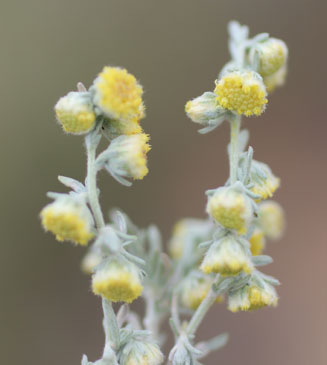
Location
In front of Visitor Center (N35D33'01.080 X W105D41'09.402)
Flowers first observed: 8/16/17
The Plant
The Flowers

Distribution
"Found in rocky, well drained soils, on dry meadows and hillsides, in desert scrub, juniper woodlands, and Ponderosa pine forests from 5,500-10,000 ft (1676-3048 m), flowers July-October Distribution: AK to Quebec, south to AZ, NM, and TX; Siberia." (SEINet)
Description
"Strongly aromatic subshrub, sometimes merely herbaceous from a woody base, 10-40 cm tall, often forming silvery mounds or mats; stems gray-green or brown, nearly glabrous to tomentose. Leaves: Basal and alternate-cauline, sessile or short-petiolate, evergreen; blades 1-2 times ternately lobed, the lobes linear to filiform, 0.2-0.5 mm wide; cauline blades less dissected than basal leaves; entire leaf 0.5-1.5 cm long, surfaces densely white or silvery-pubescent. Flowers: Flower heads disciform, arranged in leafy panicles; involucre (the ring of bracts surrounding the flower head) rounded, 2-3 mm long, 4-6 mm wide, bracts (phyllaries) numerous, in 4-7 series, gray-green, densely tomentose; florets all discs, 2 mm long, with pale yellow corollas, the outer 10-17 florets pistillate, the inner 20-50 florets bisexual. Fruits: Achenes obovate to oblanceolate, 1-1.5 mm long, somewhat compressed, smooth, shiny, faintly nerved, glabrous." (SEINet)
Ethnobotanical Uses
Medicine:
"Tea from the leaves is used by many tribes to treat cough and cold symptoms. The leaves are used by the Blackfoot and Hopi to sweeten corn. Many tribes use the plant to treat heavy bleeding. The Ramah Navajo used it ceremonially." (SEINet)
"The Cheyenne used prairie sagewort ceremonially as a smudge for purification in the Sun Dance (Hart 1976; Kinscher 1992). The Delaware- Okl chewed the leaves as a ceremonial medicine. The Blackfeet chewed the leaves of prairie sagewort for heartburn (McClintock 1923, Hellson 1974) and applied the leaves to wounds to reduce swelling. Prairie sagewort was also used to treat nosebleed by stuffing the nose with the soft leaves. The roots and tops were boiled and drank as a tea for “mountain fever.” Other tribes, who used this species of sage include the Arapaho, Comanche, Gros Ventre, Cree, Navaho, Tewa, and Ute (Nickerson 1966, Carlson and Jones 1939, Hart 1976, Thwaites 1905, Denig 1855, Elmore 1944, Robbins et al. 1916, Chamberlin 1909)." (USDA)
Internet Links
